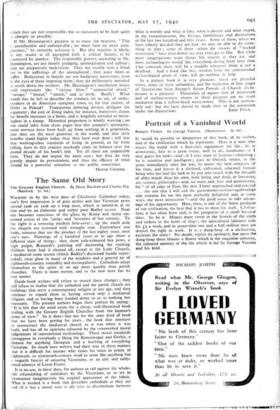The Same Old Story
The Greater English Church. By Harry Batsford and Charles Fry. (Batsford. 7s. 6d.) WALKING in by the west door of Chichester Cathedral today, one's first impression is of grey arches and late Victorian pews spread rank on rank up a long nave, .which is netted-in at its east end by an elaborate and rather poor Bodky scfeen. Next one becomes conscious of the grass, by Kemp and many un- named artists of the 'sixties and 'seventies of last century. To the right is a towering modern font-cover ; up the south aisle the chapels are screened with wrought iron. Everywhere one looks, textures that are the product of the last eighty years ..neet one's eyes. Paintings of a hundred years or so ago show a different state of things: they show pale-coloured box pews, a high pulpit, Bernardi's painting still decorating the vaulting (Gilbert Scott had it cleaned off, except in the Lady Chapel), a mediaeval stone screen (which Bodley's decorated hurdle super- seded), clear glass in many of the windows and a general air of eighteenth-century rotundity and rectangularity. Cathedrals adapt themselves to the spirit of an age more quickly than parish churches. There is more money, and so the new taste has its way sooner.
Guide-book writers still refuse to record these changes ; they still refuse to realise that the cathedral and the parish church are buildings that serve a contemporary religion in any age, and they continue to regard them as having served only a mediaeval religion, and as having been handed down to us as nothing but museums. The present authors begin their preface by saying: "It is felt that the need exists for a cheap, well-illustrated book dealing with the Greater English Churches from the layman's point of view." So it does—but not for the same kind of book that we have been getting for years, the book that attempts to reconstruct the mediaeval church as it was when it was built, and has all its opinions coloured by the overworked moral judgements of conVentional ecclesiology. These moral standards presuppose in everybody a liking for Romanesque and Gothic, a distaste for anything Georgian and a loathing of everything Victorian. So much have writers had their way in these matters that it is difficult for anyone who raises his voice in praise of eighteenth- or nineteenth-century work to seem like anything but a voguish fancier of amusing Victoriana, or an arty and sadly- dated admirer of Lovat Fraser.
It is no use, in these days, for authors to rail against the whole- sale refurnishing of cathedrals by the Victorians, or to try to reconstruct imaginatively the original appearance of the fabric. What is needed is a book that describes cathedrals as they are and (if it has a moral tone at all) tries to discriminate between what is worthy and what is fake, what is decent and what stupid, in the reconstructions, the fittings, furnishings and decorations of the last two hundred and fittv years. Some of these, when we have soberly decided they are bad, we may be able to do some- thing to alter ; some of them (when the shouts of "wicked restoration" have died down) ixe may even get to like. But while most congregations want things left exactly as they are, and most archaeologists would like everything dating from later than 1700 removed, there will be a muddle wherever there is not a deadlock. And a book like this, written from the conventional archaeological point of view, will do nothing to help.
As a picture book it is very pleasant : there are plentiful views, many of them unfamiliar, and the inclusion of four pages of illustrations from Sharpe's Seven Periods of Church Archi- tecture is a pleasure. Thousands of square feet of stonework and of surface-texture shown in these pictures are no more mediaeval than a yellow-brick water-tower. This is not particu- larly sad: but the facts should be made clear in the comments


































 Previous page
Previous page